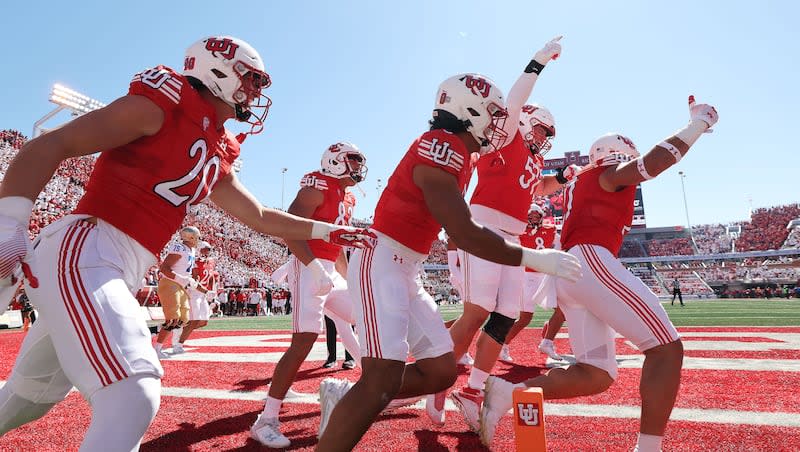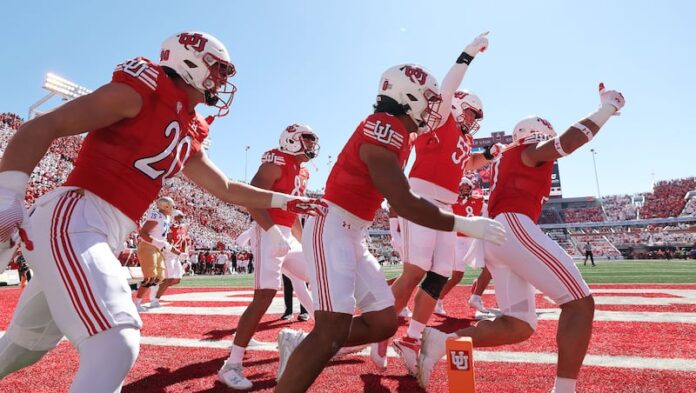
Utah was part of the test program last December, and now it’s going to be a part of college football.
Finally, in-helmet radio communication is coming to the NCAA.
The in-helmet communication system was first used in the NFL in 1994, when coaches were able to communicate with quarterbacks through the radio system. Fourteen years later, in 2008, the league also granted radio access to one defensive player, whose helmet is marked with a green dot.
The Utes tested the system out in their Las Vegas Bowl loss to Northwestern, using radio communication for one player on both offense and defense, plus tablets on the sideline for coaches to do video review with players.
Both of those changes — in-helmet radio communication and video tablets on the sideline — are being implemented in college football this fall.
That was something Utah coach Kyle Whittingham was hoping would happen after using the technology last December, noting that the radio system was a “big positive.”
“I’m hoping they adopt it next year because it makes so much sense, and all the sign stealing and the things you read about, all that crap would be out the window with the communication if they go to that,” Whittingham said last year.
The talk about implementing the radio system — which would cut down on the need to signal in plays, something especially relevant last year in the wake of the Michigan sign-stealing investigation — has been in motion for years. This offseason, the NCAA rules commission voted to allow it for FBS games.
The offensive player that will be able to access the in-helmet communication is obvious — it will be the quarterback. On defense, it’s usually the linebacker that has access. Utah linebacker Karene Reid was the primary player that had access to coaches in the Las Vegas Bowl, and that will continue this season, with Reid or someone like Lander Barton — depending on who’s in and who’s out — having radio communication.
“All six of those (linebackers) have the ability to communicate from the front all the way to the back end with the DBs. So yeah, linebackers will have that, green dot if you will,” linebackers coach Colton Swan said.
The rules are identical to the NFL — the radio will go “live” right after the play clock goes live, and will cut off when it reaches 15 seconds remaining. It’s “one-way” communication, meaning that coaches can talk to players, but players can’t talk to coaches.
In theory, this could mean the end of signaling in plays from the sideline if teams wish to do so, but it’s likely that there will still be defensive signals. There’s also an opportunity for the coach to give players some quick key pointers.
“Coach (Morgan) Scalley will have direct access to talk to them up until 15 seconds left on the play clock,” Swan said.
“We will still signal and do some things, but you don’t want to clutter their mind with too much. So telling them some crucial key points as far as situationally, clock, field position, even formationally, things like that, but allowing them to have that one-way communication with Coach Scalley.”
The tablets to review plays with players on the sidelines will provided by Microsoft, which struck a partnership with the Big 12. Microsoft also provides the tablets for the NFL.
“Used them both (tablet and in-helmet communication) and I thought it went very well, especially the tablet part of it,” Whittingham said in December.
According to the NCAA, up to 18 tablets will be available for teams to use on the sideline, in locker room and in the coaching booth. There will be multiple angles of video for teams to use — the game broadcast feed, team end zone feed and a feed from the team’s sideline.
Other rule changes adopted by the NCAA include a two-minute warning timeout, like the NFL employs, during the second and fourth quarters. A horse-collar tackle that occurs in the tackle box, previously legal, is now a 15-yard penalty.

